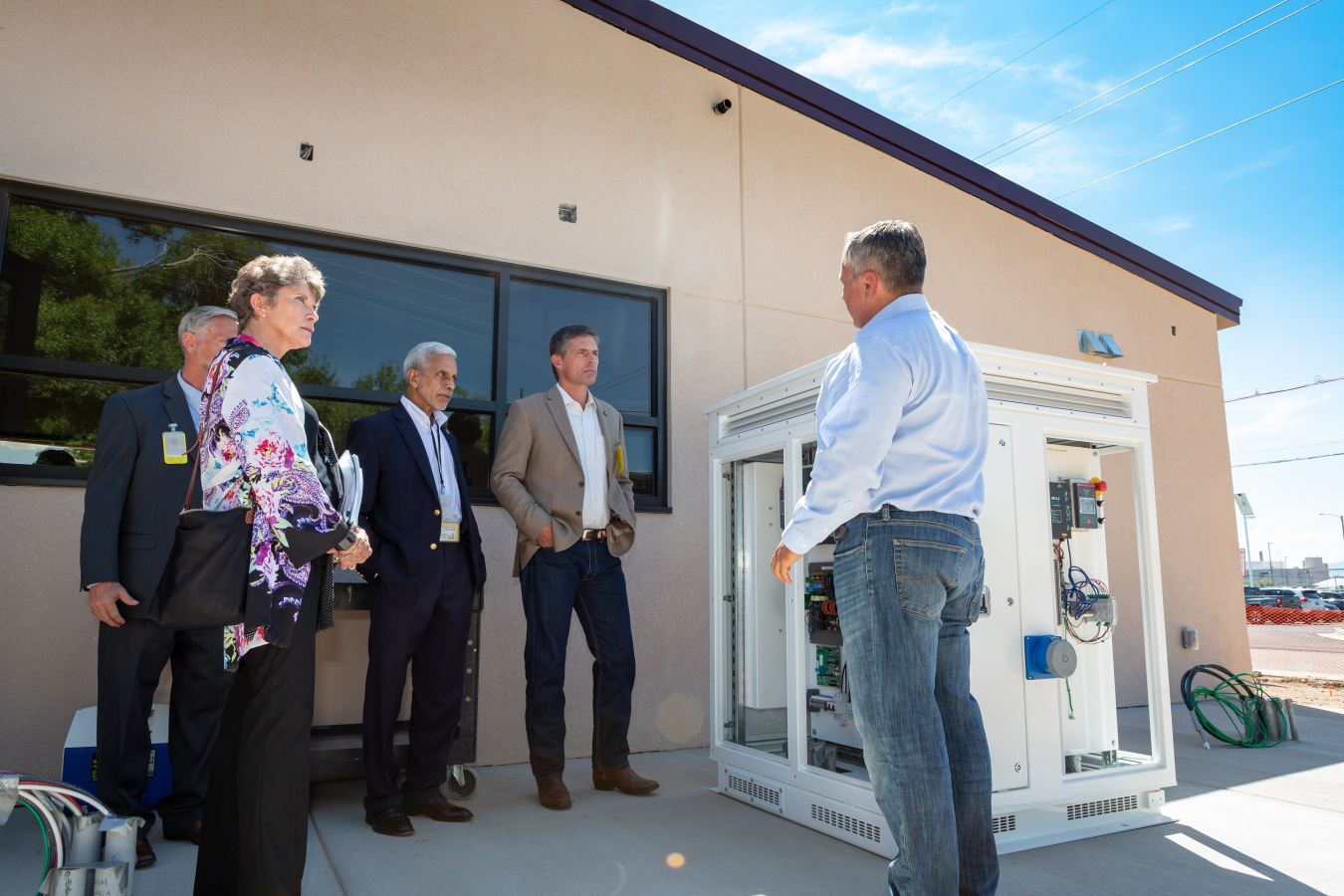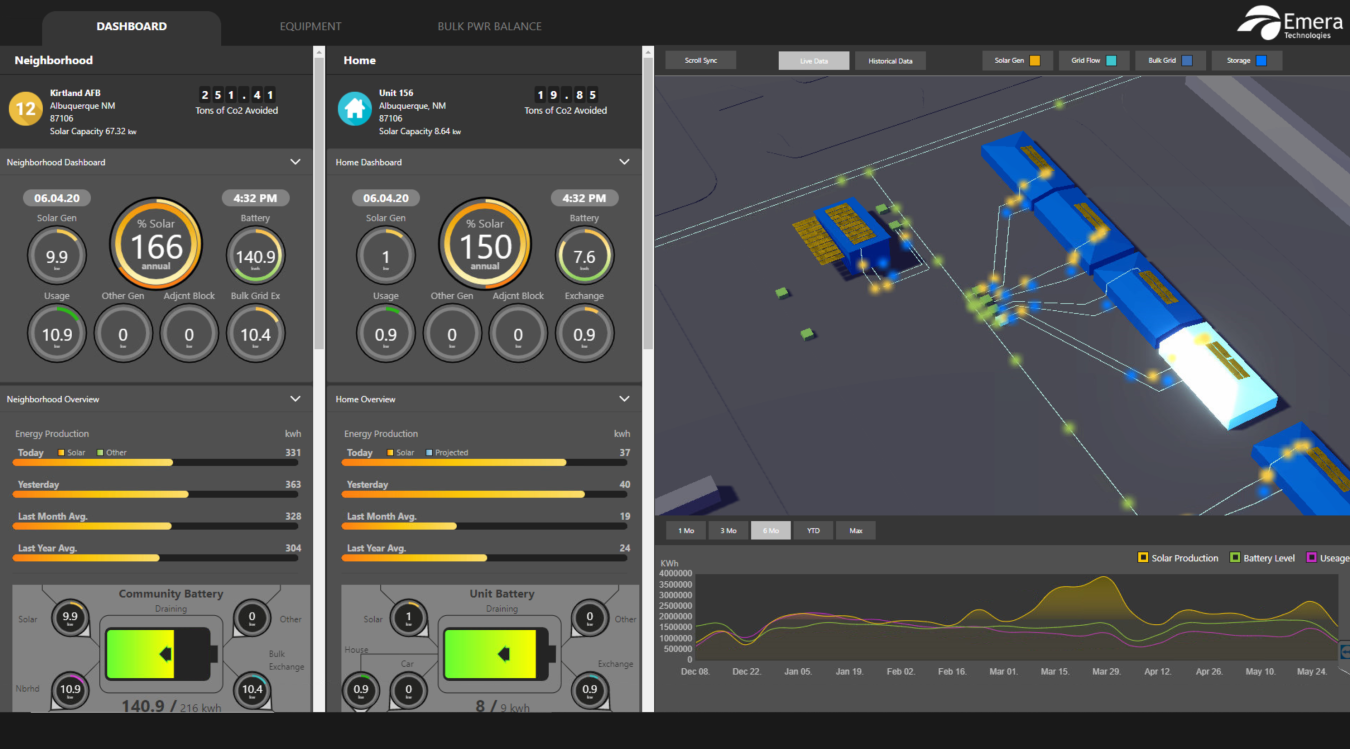An OE supported DC microgrid project at Kirtland Air Force Base generates and distributes energy independently
July 29, 2020
Senator Martin Heinrich and officials tour the DC microgrid. (L to R): Sandia Deputy Labs Director Dori Ellis; Gary Oppedahl, Emera; Abbas Akhil, Renewable Energy Ventures, LLC; Senator Martin Heinrich; and Chris Cooper, Emera.
Last fall, the first phase of a resilient DC microgrid project was brought online at Kirtland Air Force Base (KAFB) through a cooperative research and development agreement (CRADA) between Sandia National Laboratories, with funding from the Department of Energy’s Office of Electricity, and Emera Technologies.
The project, the first of its kind between U.S. Department of Energy (DOE) and U.S. Department of Defense (DoD) sites, resulted in the installation of a single-bus, ten-node 250 kW DC microgrid on KAFB that links together generation and load between Kirtland DoD facilities, Sandia’s Distributed Energy Technology Laboratory (DETL), and the Photovoltaic Systems Evaluation Laboratory (PSEL) to power a demonstration site consisting of six housing units, a laundromat and a community center as a proof of concept.
The purpose of the project is to evaluate the viability of deploying and operating DC microgrids in critical pathways for a variety of “blue sky” and “black sky” scenarios and operational control strategies. These include energy demand scenarios, how performance and stability are affected by various control schemes, and how cost/performance tradeoffs affect the relative sizing and placement of storage, converters, and other network elements. The DC system design is simpler than AC analog, with potential advantages over traditional AC microgrids when it comes to system efficiency, cost, and size. The CRADA is supported by the DOE’s Microgrid research and development (R&D) Program.
From its inception only a year ago to its unveiling last fall, the project has achieved several milestones. It has been successfully operating autonomously since December 15, 2019, functioning as a working microgrid, providing energy to the living facilities under real “blue sky” conditions as well as under a variety of simulated “black sky” scenarios. In addition to the ability to operate in normal islanded mode, the microgrid has demonstrated the ability to import/export power to the bulk-power system (BPS), black start the entirety of the microgrid, and achieve long-term, self-sustained operation, with a goal of attaining consistent, sustained operation with an average renewable penetration greater than 100 percent. During its six-month operation, it has exported excess renewable generation onto the grid.
The microgrid at KAFB consists of a hierarchical, modular power electronics-based interface at each node that contains power conversion, control, protection, and storage. These modular power blocks are connected on a common DC bus operated at a bipolar +/- 375 VDC to form a block community. These block communities can be interconnected to the BPS and/or interconnected to each other. Each power block is a self-contained unit that can store energy, provide either DC or AC load, and import/export power to the microgrid.
The microgrid project at KAFB combines solar photovoltaics, battery storage, and natural gas, in addition to electric vehicle chargers. Testing and validation are enabled through electrical and communication connections to the Sandia DETL research and development center.
The DC microgrid exemplifies effective partnerships between government, private industry, and the National Laboratories to conduct meaningful R&D on a practical, real-world energy test bed. As a novel concept for addressing energy at the grid edge and increasing resilience to our Nation’s military installations, the microgrid is a site for conducting energy, cybersecurity, and protection projects. These projects contribute to a secure and reliable electric grid that meets future needs for adaptable energy on the distribution side, seamlessly combining conventional and renewable sources of energy.

System dashboard showing power distribution through the community center and base housing portions of the DC microgrid at KAFB.
Dan Ton

Dan Ton is Program Manager at the U.S. Department of Energy (DOE) Office of Electricity (OE), responsible for developing and managing the OE Microgrids R&D Program. He also serves as the OE lead for the Community Microgrid Assistance Partnership (C-MAP) program.
From May 2014 until July 2015, he served as Acting Deputy Assistant Secretary of OE’s Power Systems Engineering Division. Before joining OE, Dan managed the Renewable Systems Integration program within the DOE Solar Energy Technologies Program.
Dan holds a Bachelor of Science in Electrical Engineering and a Master of Science in Business Management, both from the University of Maryland.


